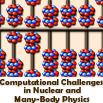Speaker
Prof.
Paul Ayers
(Dept. of Chemistry & Chemical Biology; McMaster University)
Description
Modeling strong correlation is so difficult that theorists often settle for qualitative
descriptions of strongly-correlated substances (e.g. heavy-fermion materials, high-
temperature superconductors). These qualitative approaches are typically based on
model Hamiltonians for which the Schrödinger equation can be solved exactly via the
Bethe ansatz. We recently realized that one can use the wavefunction-forms from
exactly-solvable model Hamiltonians for calculations with the true Hamiltonian (with
electrons and nuclei). Choosing a suitable model Hamiltonian ensures that the key
qualitative features of the system are all captured, while the computational cost
remains low because the exactly solvable model systems can be represented using
independent quasiparticles. Our results from wavefunction-forms from the Richardson-
Gaudin family of Hamiltonians have remarkable quantitative accuracy: the ground-state
energies are typically within 0.001 eV of benchmark results from complete
diagonalization in the exponentially big Hilbert space of paired electrons (i.e., doubly-
occupied configuration interaction). Using symmetry-broken (unrestricted or general
mixed-spin) orbitals to form the Richardson-pairs improves the results still further, and
is especially important for spin-frustrated and non-singlet states. The models we
present are highly effective for modelling strong correlation, but computationally
efficient enough to be applied to large molecules.
Author
Prof.
Paul Ayers
(Dept. of Chemistry & Chemical Biology; McMaster University)
Co-authors
Dimitri Van Neck
(Dept. of Physics; Ghent University)
Katharina Boguslaski
(Dept. of Chemistry & Chemical Biology; McMaster University)
Patrick Bultinck
(Dept. of Chemistry; Ghent University)
Paul Johnson
(Dept. of Chemistry & Chemical Biology; McMaster University)
Pawel Tecmer
(Dept. of Chemistry & Chemical Biology; McMaster University)
Peter Limacher
(Dept. of Chemistry & Chemical Biology; McMaster University)
Stijn De Baerdemackers
(Dept. of Physics; Ghent University)

